Abstract
OBJECTIVE: To examine the long-term benefits and safety of aerobic training in patients with chronic heart failure. DESIGN: Non-randomised control trial with 52 weeks follow up. SETTING: Outpatient cardiac rehabilitation referral centre. PATIENTS: Patients with compensated chronic heart failure (mean (SD) age 62 (6) years, New York Heart Association stage III, initial resting ejection fraction 22 (7)%). Experimental group of 17 men, 4 women; control group 8 men, 1 woman. INTERVENTIONS: Experimental group: progressive, supervised aerobic walking programme for 52 weeks. Control group: standard medical treatment. MAIN OUTCOME MEASURES: Six-minute walk distance, progressive cycle ergometer test to subjective exhaustion, disease-specific quality of life questionnaire, and standard gamble test, all measured at entry, 4, 8, 12, 16, 26, and 52 weeks. RESULTS: Control data showed no changes except a small trend to improved emotional function (P = 0.02 at 12 weeks only). Fifteen of the 21 patients completed all 52 weeks of aerobic training; two withdrew for non-cardiac reasons (16, 52 weeks). Three were withdrawn because of worsening cardiac failure unrelated to their exercise participation (4, 4, 8 weeks), and one had a non-fatal cardiac arrest while shopping (16 weeks). Gains of cardiorespiratory function plateaued at 16-26 weeks, with 10-15% improvement in six-minute walk, peak power output, and peak oxygen intake linked to gains in oxygen pulse and ventilatory threshold and reductions in resting heart rate. Marked improvements in quality of life followed a parallel course. CONCLUSIONS: Aerobic training is safe and beneficial in compensated chronic heart failure. Gains in aerobic function and quality of life persisted over a programme lasting 52 weeks.
Full text
PDF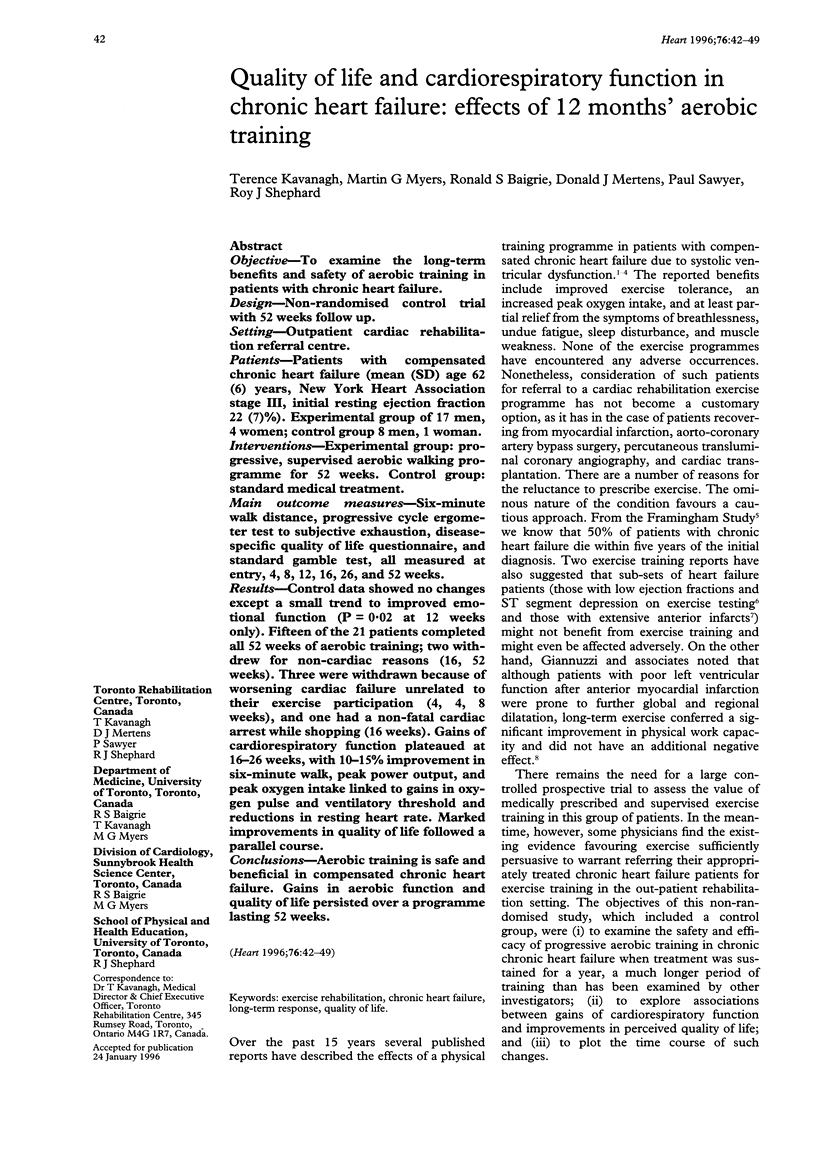
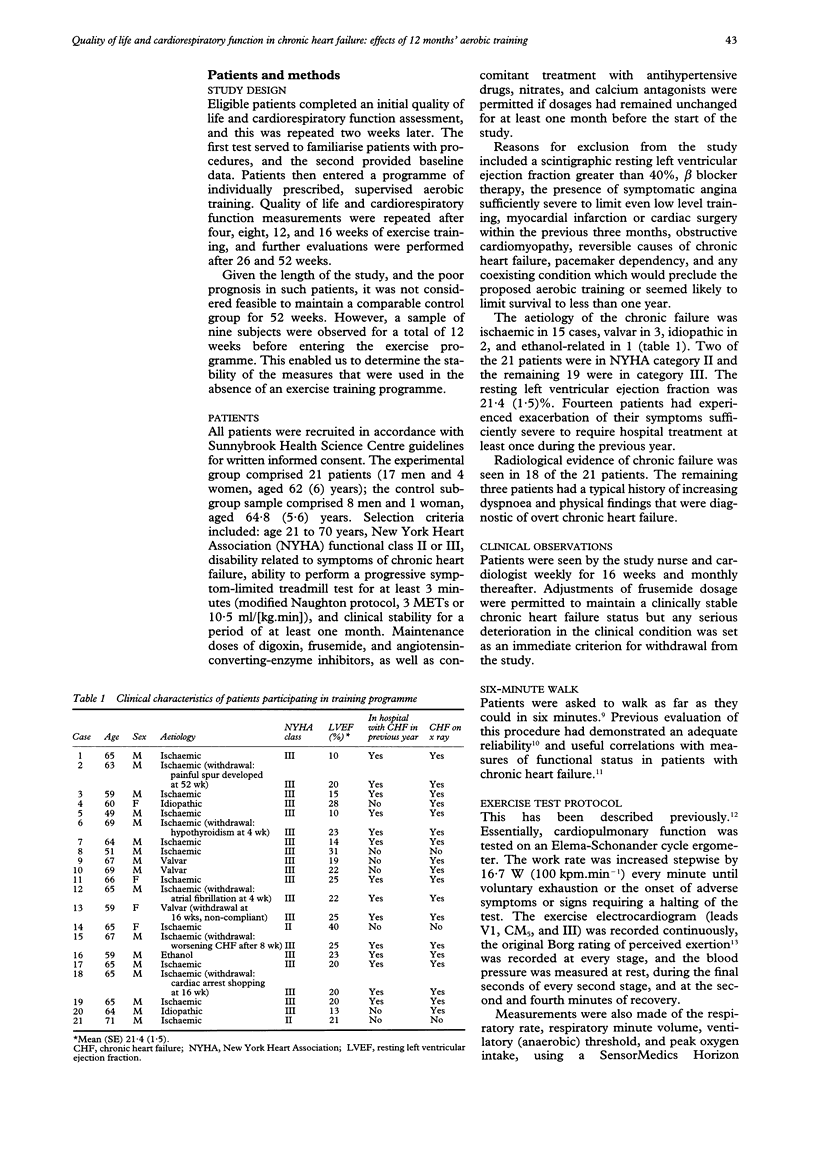
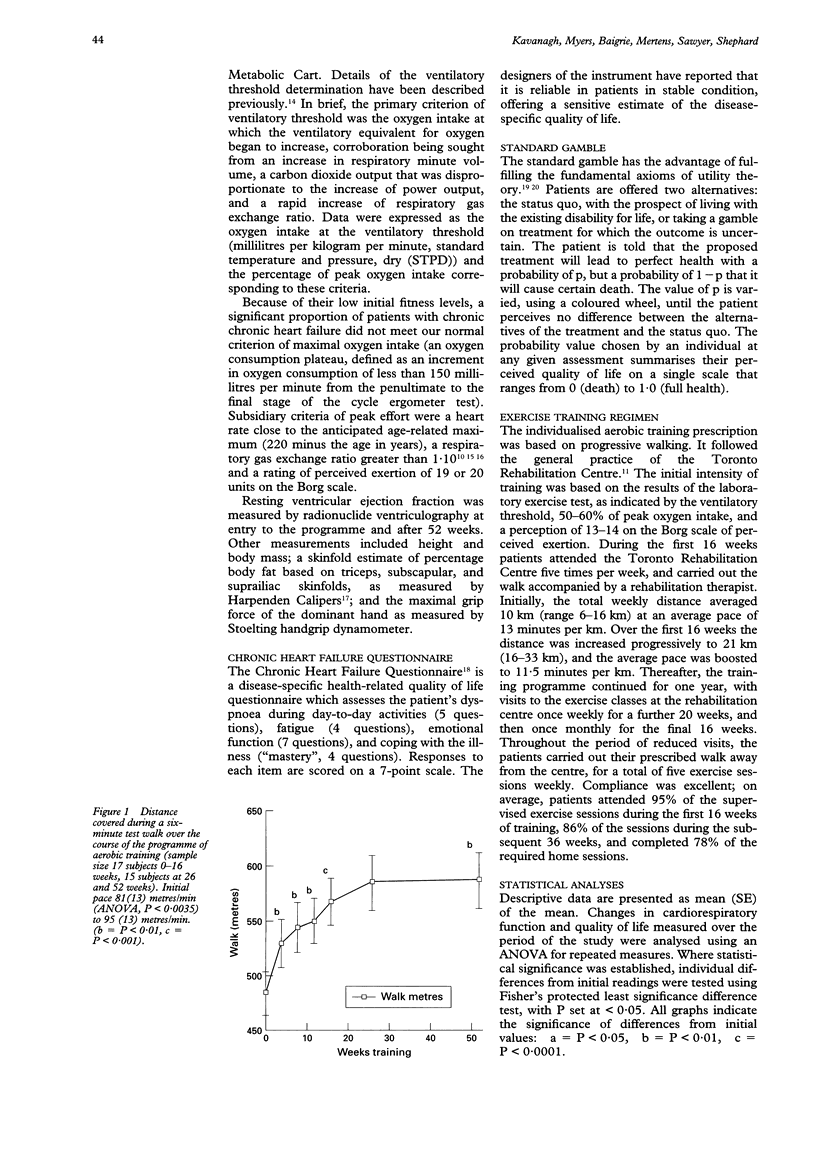
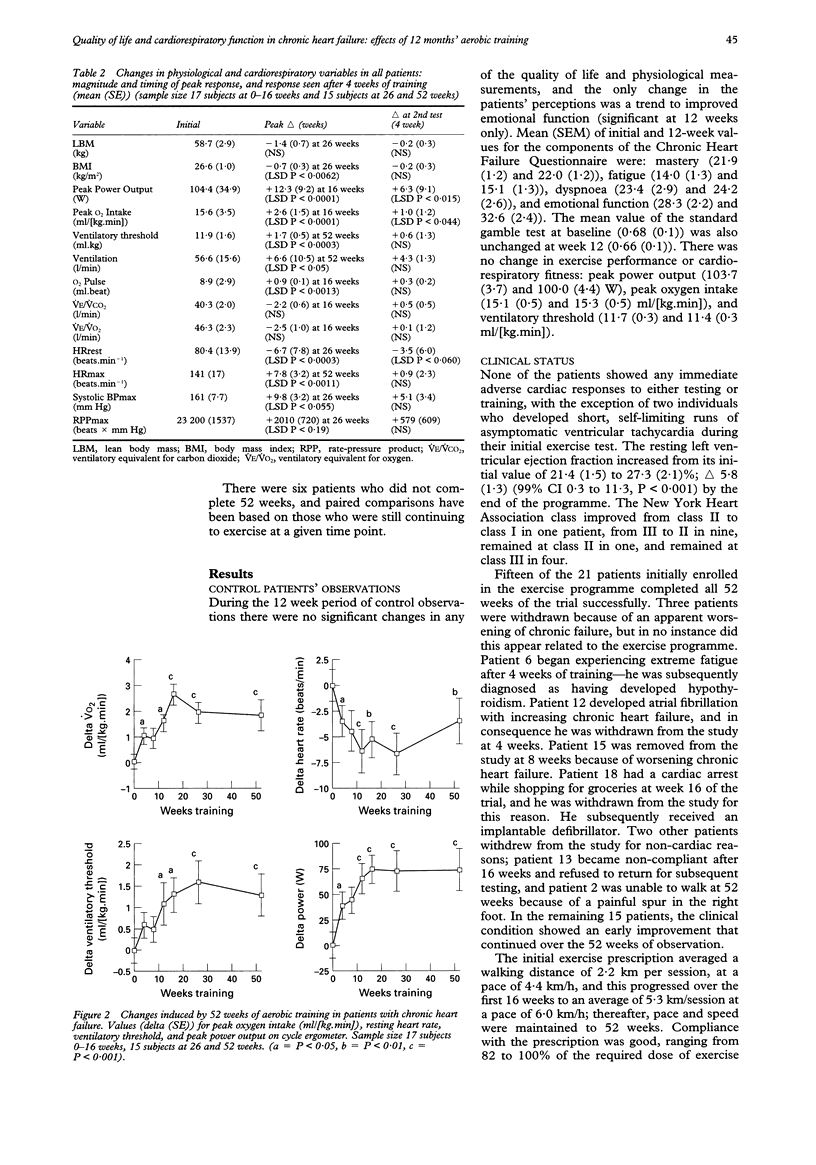
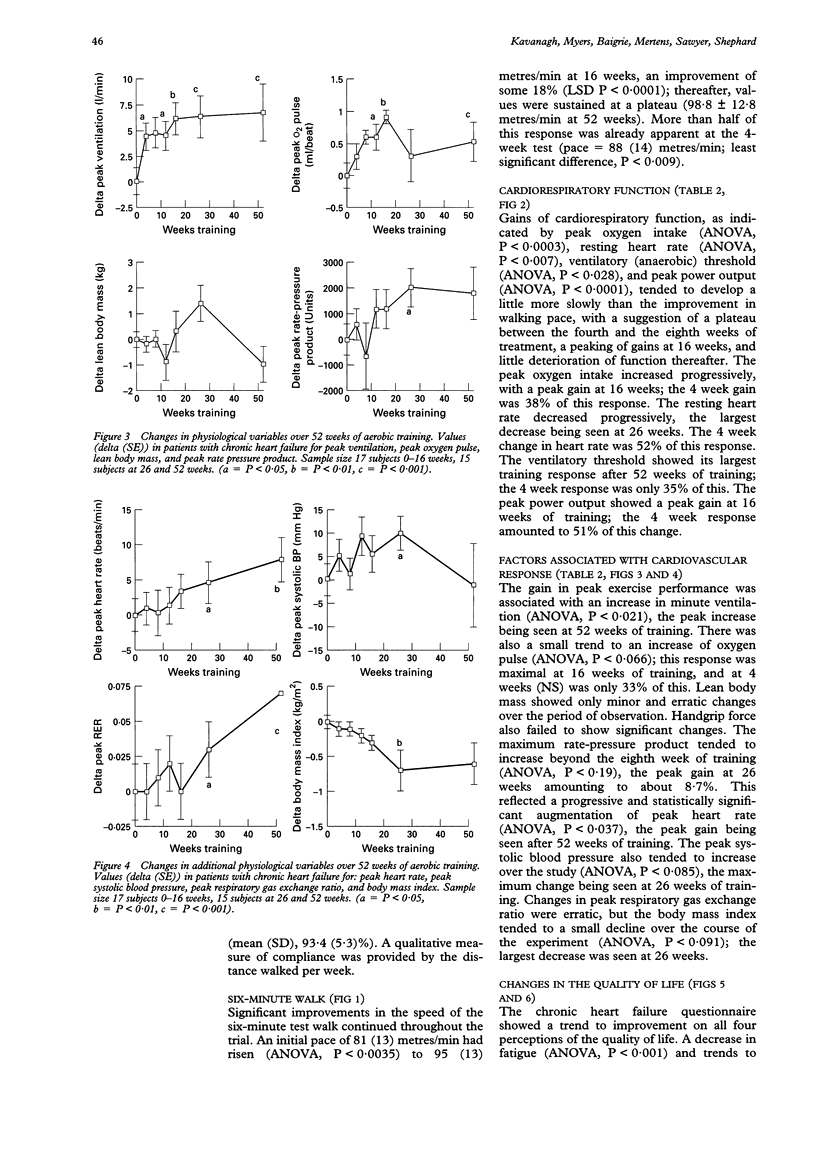
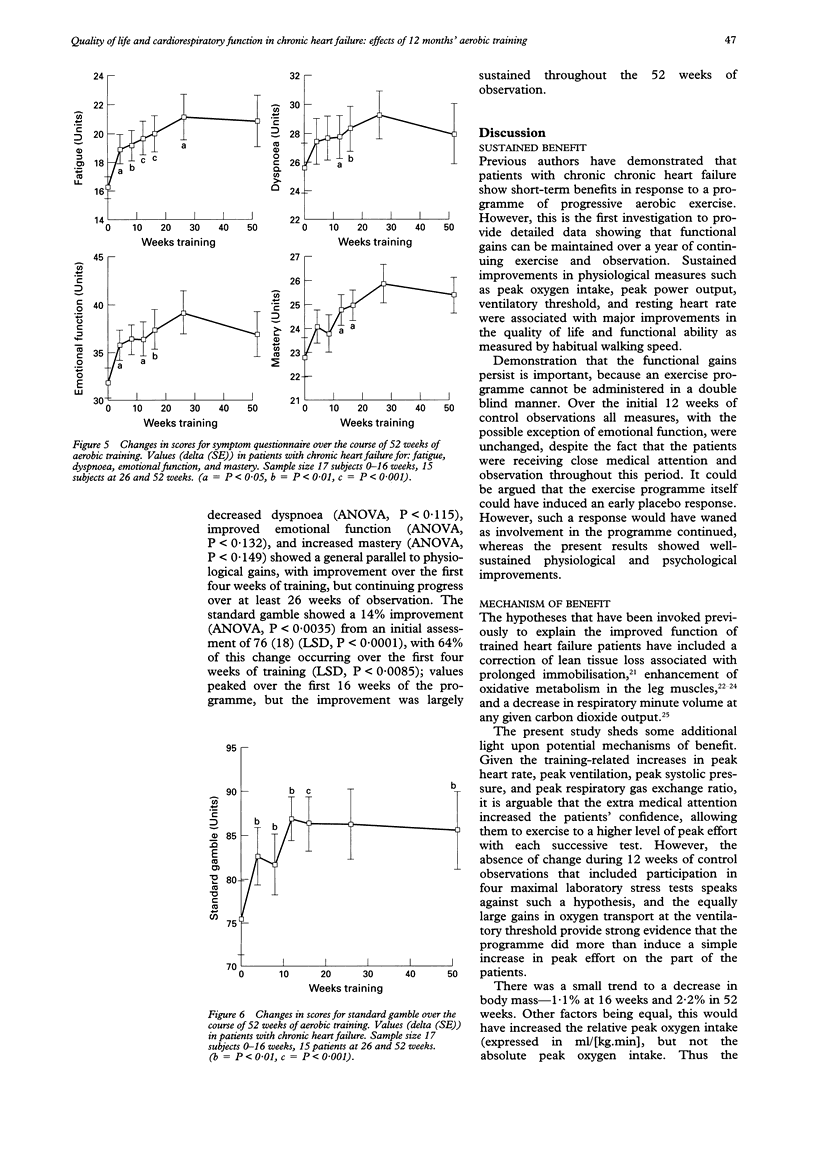
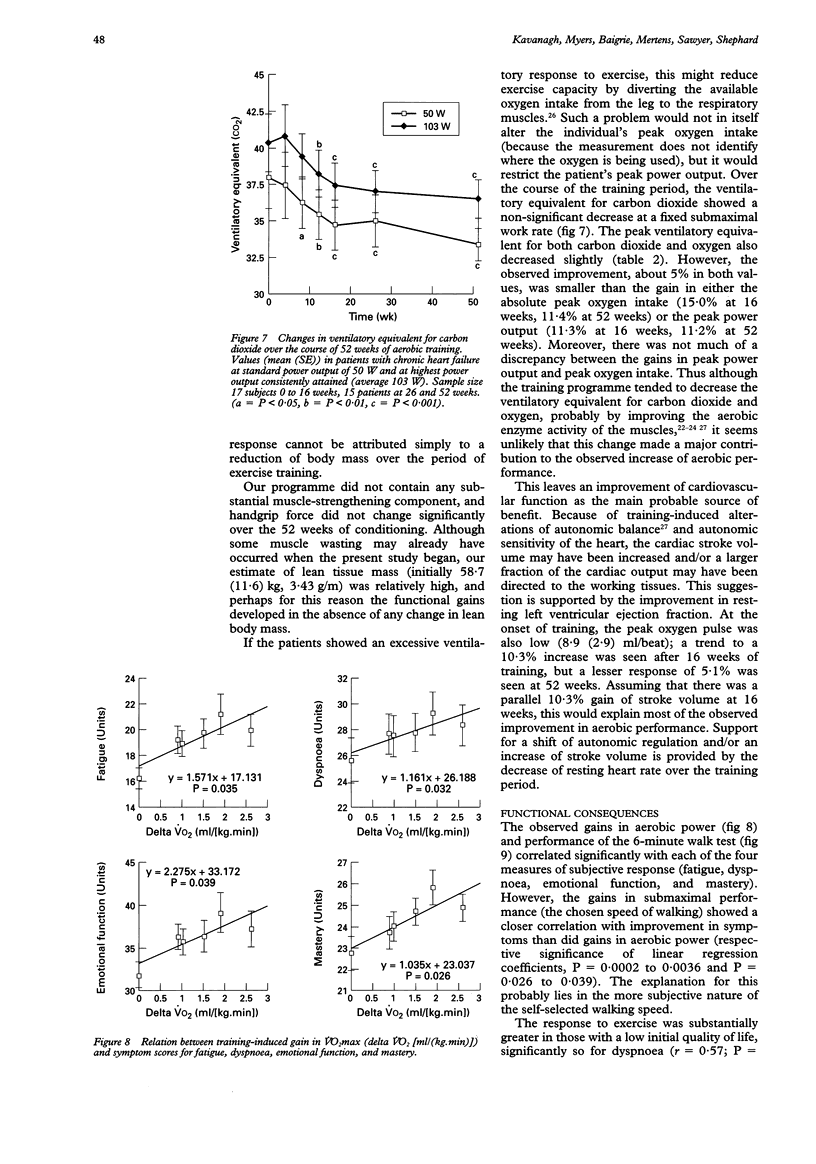
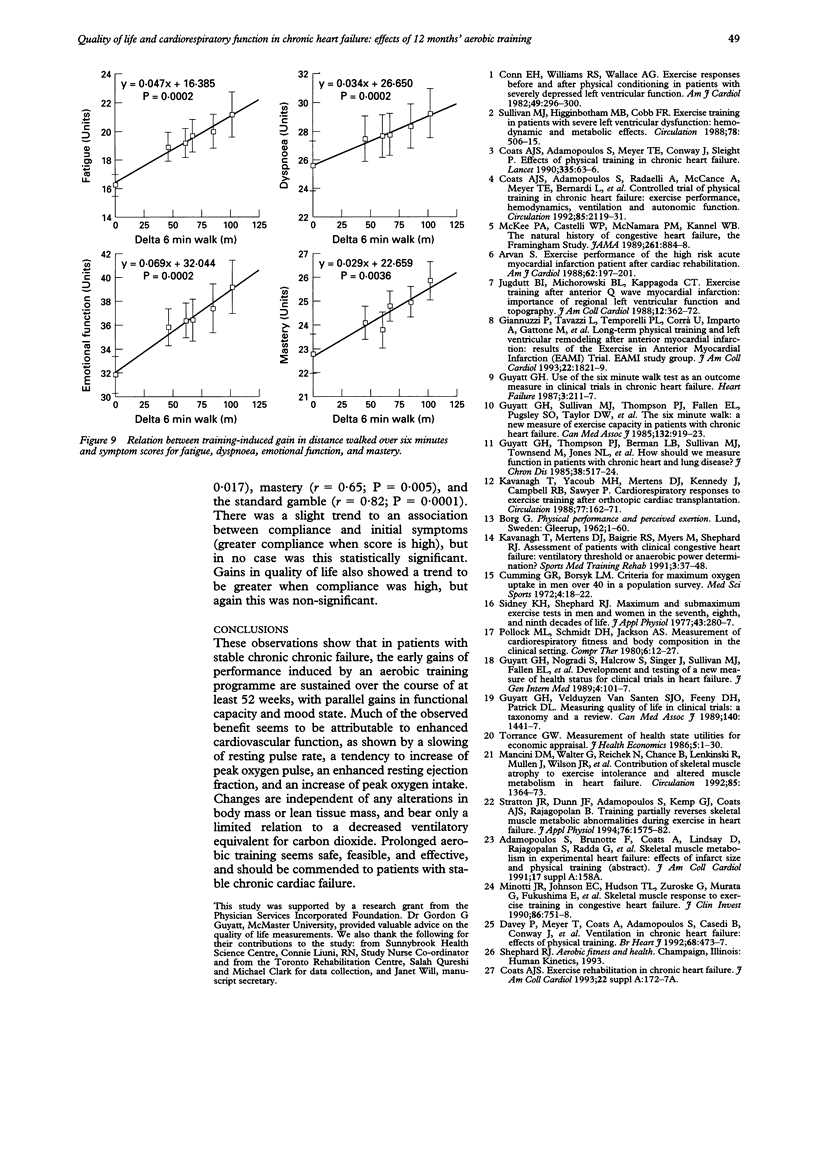
Selected References
These references are in PubMed. This may not be the complete list of references from this article.
- Arvan S. Exercise performance of the high risk acute myocardial infarction patient after cardiac rehabilitation. Am J Cardiol. 1988 Aug 1;62(4):197–201. doi: 10.1016/0002-9149(88)90211-1. [DOI] [PubMed] [Google Scholar]
- Coats A. J., Adamopoulos S., Meyer T. E., Conway J., Sleight P. Effects of physical training in chronic heart failure. Lancet. 1990 Jan 13;335(8681):63–66. doi: 10.1016/0140-6736(90)90536-e. [DOI] [PubMed] [Google Scholar]
- Coats A. J., Adamopoulos S., Radaelli A., McCance A., Meyer T. E., Bernardi L., Solda P. L., Davey P., Ormerod O., Forfar C. Controlled trial of physical training in chronic heart failure. Exercise performance, hemodynamics, ventilation, and autonomic function. Circulation. 1992 Jun;85(6):2119–2131. doi: 10.1161/01.cir.85.6.2119. [DOI] [PubMed] [Google Scholar]
- Conn E. H., Williams R. S., Wallace A. G. Exercise responses before and after physical conditioning in patients with severely depressed left ventricular function. Am J Cardiol. 1982 Feb 1;49(2):296–300. doi: 10.1016/0002-9149(82)90504-5. [DOI] [PubMed] [Google Scholar]
- Cumming G. R., Borysyk L. M. Criteria for maximum oxygen uptake in men over 40 in a population survey. Med Sci Sports. 1972 Spring;4(1):18–22. [PubMed] [Google Scholar]
- Davey P., Meyer T., Coats A., Adamopoulos S., Casadei B., Conway J., Sleight P. Ventilation in chronic heart failure: effects of physical training. Br Heart J. 1992 Nov;68(5):473–477. doi: 10.1136/hrt.68.11.473. [DOI] [PMC free article] [PubMed] [Google Scholar]
- Giannuzzi P., Tavazzi L., Temporelli P. L., Corrà U., Imparato A., Gattone M., Giordano A., Sala L., Schweiger C., Malinverni C. Long-term physical training and left ventricular remodeling after anterior myocardial infarction: results of the Exercise in Anterior Myocardial Infarction (EAMI) trial. EAMI Study Group. J Am Coll Cardiol. 1993 Dec;22(7):1821–1829. doi: 10.1016/0735-1097(93)90764-r. [DOI] [PubMed] [Google Scholar]
- Guyatt G. H., Nogradi S., Halcrow S., Singer J., Sullivan M. J., Fallen E. L. Development and testing of a new measure of health status for clinical trials in heart failure. J Gen Intern Med. 1989 Mar-Apr;4(2):101–107. doi: 10.1007/BF02602348. [DOI] [PubMed] [Google Scholar]
- Guyatt G. H., Sullivan M. J., Thompson P. J., Fallen E. L., Pugsley S. O., Taylor D. W., Berman L. B. The 6-minute walk: a new measure of exercise capacity in patients with chronic heart failure. Can Med Assoc J. 1985 Apr 15;132(8):919–923. [PMC free article] [PubMed] [Google Scholar]
- Guyatt G. H., Thompson P. J., Berman L. B., Sullivan M. J., Townsend M., Jones N. L., Pugsley S. O. How should we measure function in patients with chronic heart and lung disease? J Chronic Dis. 1985;38(6):517–524. doi: 10.1016/0021-9681(85)90035-9. [DOI] [PubMed] [Google Scholar]
- Guyatt G. H., Veldhuyzen Van Zanten S. J., Feeny D. H., Patrick D. L. Measuring quality of life in clinical trials: a taxonomy and review. CMAJ. 1989 Jun 15;140(12):1441–1448. [PMC free article] [PubMed] [Google Scholar]
- Jugdutt B. I., Michorowski B. L., Kappagoda C. T. Exercise training after anterior Q wave myocardial infarction: importance of regional left ventricular function and topography. J Am Coll Cardiol. 1988 Aug;12(2):362–372. doi: 10.1016/0735-1097(88)90407-x. [DOI] [PubMed] [Google Scholar]
- Kavanagh T., Yacoub M. H., Mertens D. J., Kennedy J., Campbell R. B., Sawyer P. Cardiorespiratory responses to exercise training after orthotopic cardiac transplantation. Circulation. 1988 Jan;77(1):162–171. doi: 10.1161/01.cir.77.1.162. [DOI] [PubMed] [Google Scholar]
- Mancini D. M., Walter G., Reichek N., Lenkinski R., McCully K. K., Mullen J. L., Wilson J. R. Contribution of skeletal muscle atrophy to exercise intolerance and altered muscle metabolism in heart failure. Circulation. 1992 Apr;85(4):1364–1373. doi: 10.1161/01.cir.85.4.1364. [DOI] [PubMed] [Google Scholar]
- Minotti J. R., Johnson E. C., Hudson T. L., Zuroske G., Murata G., Fukushima E., Cagle T. G., Chick T. W., Massie B. M., Icenogle M. V. Skeletal muscle response to exercise training in congestive heart failure. J Clin Invest. 1990 Sep;86(3):751–758. doi: 10.1172/JCI114771. [DOI] [PMC free article] [PubMed] [Google Scholar]
- Pollack M. L., Schmidt D. H., Jackson A. S. Measurement of cardio-respiratory fitness and body composition in the clinical setting. Compr Ther. 1980 Sep;6(9):12–27. [PubMed] [Google Scholar]
- Sidney K. H., Shephard R. J. Maximum and submaximum exercise tests in men and women in the seventh, eighth, and ninth decades of life. J Appl Physiol Respir Environ Exerc Physiol. 1977 Aug;43(2):280–287. doi: 10.1152/jappl.1977.43.2.280. [DOI] [PubMed] [Google Scholar]
- Stevenson L. W., Perloff J. K. The limited reliability of physical signs for estimating hemodynamics in chronic heart failure. JAMA. 1989 Feb 10;261(6):884–888. [PubMed] [Google Scholar]
- Stratton J. R., Dunn J. F., Adamopoulos S., Kemp G. J., Coats A. J., Rajagopalan B. Training partially reverses skeletal muscle metabolic abnormalities during exercise in heart failure. J Appl Physiol (1985) 1994 Apr;76(4):1575–1582. doi: 10.1152/jappl.1994.76.4.1575. [DOI] [PubMed] [Google Scholar]
- Sullivan M. J., Higginbotham M. B., Cobb F. R. Exercise training in patients with severe left ventricular dysfunction. Hemodynamic and metabolic effects. Circulation. 1988 Sep;78(3):506–515. doi: 10.1161/01.cir.78.3.506. [DOI] [PubMed] [Google Scholar]
- Torrance G. W. Measurement of health state utilities for economic appraisal. J Health Econ. 1986 Mar;5(1):1–30. doi: 10.1016/0167-6296(86)90020-2. [DOI] [PubMed] [Google Scholar]


